Development of Hybrid Surfaces with Tunable Wettability by Selective Surface Modifications
Abstract
:1. Introduction
2. Materials and Methods
2.1. Materials
2.2. Selective Micropatterning
2.2.1. Preparation of a Micropatterned Mold
2.2.2. Selective Micropattern Replication
2.3. Selective Fluorinate Coating
2.4. Electron Beam Irradiation
2.5. Chracterization
3. Results
3.1. Surface Hydrophobitization Using Selective Micropatterning
3.2. Surface Hydrophobitization Using Selective Fluoriate Coating
3.3. Surface Hydrophlization Using Electron Beam Irradiation
4. Discussion
4.1. Investigation of Selective Wettability
4.2. Water Collection of the Developed Hybrid Surface
4.3. Development of Hybrid Surface with Tunable Wettability
5. Conclusions
Acknowledgments
Author Contributions
Conflicts of Interest
References
- Koch, K.; Bhushan, B.; Barthlott, W. Multifunctional surface structures of plants: An inspiration for biomimetics. Prog. Mater. Sci. 2009, 54, 137–178. [Google Scholar] [CrossRef]
- Yao, X.; Song, Y.; Jiang, L. Applications of bio-inspired special wettable surfaces. Adv. Mater. 2011, 23, 719–734. [Google Scholar] [CrossRef] [PubMed]
- Bhushan, B.; Jung, Y.C. Natural and biomimetic artificial surfaces for superhydrophobicity, self-cleaning, low adhesion, and drag reduction. Prog. Mater. Sci. 2011, 56, 1–108. [Google Scholar] [CrossRef]
- Feng, L.; Li, S.; Li, Y.S.; Li, H.J.; Zhang, L.; Zhai, J.; Song, Y.; Liu, B.; Jiang, L.; Zhu, D. Super-hydrophobic surfaces: From natural to artificial. Adv. Mater. 2002, 14, 1857–1860. [Google Scholar] [CrossRef]
- Lafuma, A.; Quéré, D. Superhydrophobic states. Nature Mater. 2003, 2, 457–460. [Google Scholar] [CrossRef] [PubMed]
- Guo, Z.; Liu, W.; Su, B.L. Superhydrophobic surfaces: From natural to biomimetic to functional. J. Colloid. Interface Sci. 2011, 353, 335–355. [Google Scholar] [CrossRef] [PubMed]
- Hamilton, W.J. Fog Basking by the namib desert beetle, Onymacris unguicularis. Nature 1976, 262, 284–285. [Google Scholar] [CrossRef]
- Parker, A.R.; Lawrence, C.R. Water capture by a desert beetle. Nature 2001, 414, 33–34. [Google Scholar] [CrossRef] [PubMed]
- Li, X.M.; Reinhoudt, D.; Crego-Calama, M. What do we need for a superhydrophobic surface? A review on the recent progress in preparation of superhydrophobic surfaces. Chem. Soc. Rev. 2007, 36, 1350–1368. [Google Scholar] [CrossRef] [PubMed]
- Xue, C.H.; Jia, S.T.; Zhang, J.; Ma, J.Z. Large-area fabrication of superhydrophobic surfaces for practical applications: an overview. Sci. Technol. Adv. Mater. 2010, 11, 033002. [Google Scholar] [CrossRef]
- Fürstner, R.; Barthlott, W.; Neinhuis, C.; Walzel, P. Wetting and self-cleaning properties of artificial superhydrophobic surfaces. Langmuir 2005, 21, 956–961. [Google Scholar] [CrossRef] [PubMed]
- Suh, K.Y.; Jon, S. Control over wettability of polyethylene glycol surfaces using capillary lithography. Langmuir 2005, 21, 6836–6841. [Google Scholar] [CrossRef] [PubMed]
- Zhang, G.; Wang, D.; Gu, Z.Z.; Möhwald, H. Fabrication of superhydrophobic surfaces from binary colloidal assembly. Langmuir 2005, 21, 9143–9148. [Google Scholar] [CrossRef] [PubMed]
- Vourdas, N.; Tserepi, A.; Gogolides, E. Nanotextured super-hydrophobic transparent poly(methyl methacrylate) surfaces using high-density plasma processing. Nanotechnology 2007, 18, 125304. [Google Scholar] [CrossRef]
- Huang, L.; Lau, S.P.; Yang, H.Y.; Leong, E.S.P.; Yu, S.F.; Prawer, S. Stable superhydrophobic surface via carbon nanotubes coated with a ZnO thin film. J. Phys. Chem. B 2005, 109, 7746–7748. [Google Scholar] [CrossRef] [PubMed]
- Manca, M.; Cannavale, A.; De Marco, L.; Arico, A.S.; Cingolani, R.; Gigli, G. Durable superhydrophobic and antireflective surfaces by trimethylsilanized silica nanoparticles-based sol-gel processing. Langmuir 2009, 25, 6357–6362. [Google Scholar] [CrossRef] [PubMed]
- Cho, Y.H.; Seo, Y.S.; Moon, I.Y.; Kim, B.H.; Park, K. Facile fabrication of superhydrophobic poly (methyl methacrylate) substrates using ultrasonic imprinting. J. Micromech. Microeng. 2013, 23, 055019. [Google Scholar] [CrossRef]
- Hosono, E.; Fujihara, S.; Honma, I.; Zhou, H. Superhydrophobic perpendicular nanopin film by the bottom-up process. J. Am. Chem. Soc. 2005, 127, 13458–13459. [Google Scholar] [CrossRef] [PubMed]
- Shi, F.; Chen, X.; Wang, L.; Niu, J.; Yu, J.; Wang, Z.; Zhang, X. Roselike microstructures formed by direct in situ hydrothermal synthesis: From superhydrophilicity to superhydrophobicity. Chem. Mater. 2005, 17, 6177–6180. [Google Scholar] [CrossRef]
- Gao, L.; McCarthy, T.J. “Artificial lotus leaf” prepared using a 1945 patent and a commercial textile. Langmuir 2006, 22, 5998–6000. [Google Scholar] [CrossRef] [PubMed]
- Levkin, P.A.; Svec, F.; Fréchet, J.M. Porous polymer coatings: A versatile approach to superhydrophobic surfaces. Adv. Func. Mater. 2009, 19, 1993–1998. [Google Scholar] [CrossRef] [PubMed]
- Chou, S.Y.; Krauss, P.R.; Renstrom, P.J. Nanoimprint lithography. J. Vacuum Sci. 1996, 14, 4129–4133. [Google Scholar] [CrossRef]
- Heckel, M.; Schomburg, W.K. Review on micro molding of thermoplastic polymers. J. Micromech. Microeng. 2004, 14, R1–R14. [Google Scholar] [CrossRef]
- Chou, S.Y.; Krauss, P.R.; Zhang, W.; Guo, L.; Zhuang, L. Sub-10 nm imprint lithography and applications. J. Vac. Sci. Technol. B 1997, 15, 2897–2904. [Google Scholar] [CrossRef]
- Sackmann, J.; Burlage, K.; Gerhardy, C.; Memering, B.; Liao, S.; Schomburg, W.K. Review on ultrasonic fabrication of polymer micro devices. Ultrasonics 2015, 56, 189–200. [Google Scholar] [CrossRef] [PubMed]
- Lee, H.J.; Park, K. Development of composite micro-patterns on polymer film using repetitive ultrasonic imprinting. Int. J. Precis. Eng. Manuf. Green Technol. 2014, 1, 341–345. [Google Scholar] [CrossRef]
- Jung, W.; Lee, H.J.; Park, K. Micropattern replication characteristics in selective ultrasonic imprinting using negative masks. Int. J. Precis. Engng. Manuf. 201 2015, 16, 1999–2004. [Google Scholar] [CrossRef]
- Garrod, R.P.; Harris, L.G.; Schofield, W.C.E.; McGettrick, J.; Ward, L.J.; Teare, D.O.H.; Badyal, J.P.S. Mimicking a Stenocara beetle's back for microcondensation using plasmachemical patterned superhydrophobic-superhydrophilic surfaces. Langmuir 2007, 23, 689–693. [Google Scholar] [CrossRef] [PubMed]
- Kobayashi, T.; Shimizu, K.; Kaizuma, Y.; Konishi, S. Novel combination of hydrophilic/hydrophobic surface for large wettability difference and its application to liquid manipulation. Lab. Chip. 2011, 11, 639–644. [Google Scholar] [CrossRef] [PubMed]
- Lee, A.; Moon, M.W.; Lim, H.; Kim, W.D.; Kim, H.Y. Water harvest via dewing. Langmuir 2012, 28, 10183–10191. [Google Scholar] [CrossRef] [PubMed]
- Dorrer, C.; Rühe, J. Mimicking the Stenocara beetle–dewetting of drops from a patterned superhydrophobic surface. Langmuir 2008, 24, 6154–6158. [Google Scholar] [CrossRef] [PubMed]
- Ma, K.; Rivera, J.; Hirasaki, G.J.; Biswal, S.L. Wettability control and patterning of PDMS using UV-ozone and water immersion. J. Colloid Interf. Sci. 2011, 363, 371–378. [Google Scholar] [CrossRef] [PubMed]
- Zahner, D.; Abagat, J.; Svec, F.; Fréchet, J.M.; Levkin, P.A. A facile approach to superhydrophilic–superhydrophobic patterns in porous polymer films. Adv. Mater. 2011, 23, 3030–3034. [Google Scholar] [CrossRef] [PubMed]
- Kang, S.M.; You, I.; Cho, W.K.; Shon, H.K.; Lee, T.G.; Choi, I.S.; Karp, J.M.; Lee, H. One-step modification of superhydrophobic surfaces by a mussel-inspired polymer coating. Angew. Chem. Int. Ed. 2010, 49, 9401–9404. [Google Scholar] [CrossRef] [PubMed]
- Ngo, C.V.; Davaasuren, G.; Oh, H.S.; Chun, D.M. Transparency and superhydrophobicity of cone-shaped micropillar array textured polydimethylsiloxane. Int. J. Precis. Engng. Manuf. 2015, 16, 1999–2004. [Google Scholar] [CrossRef]
- Huang, D.J.; Leu, T.S. Fabrication of a wettability-gradient surface on copper by screen-printing techniques. J. Micromech. Microeng. 2015, 25, 085007. [Google Scholar] [CrossRef]
- Lee, H.J.; Park, K. Development of composite micro-patterns on polymer film using repetitive ultrasonic imprinting. Collids Polym. Sci. 2016. in revision. [Google Scholar] [CrossRef]
- Jung, W.; Park, K. Selective ultrasonic imprinting for micropattern replication on predefined area. Ultrasonics 201 2014, 54, 1495–1503. [Google Scholar] [CrossRef] [PubMed]
- Makuuchi, K.; Cheng, S. Radiation Processing of Polymer Materials and Its Industrial Applications; John Wiley & Sons, Inc.: Hoboken, NJ, USA, 2012; pp. 230–242. [Google Scholar]
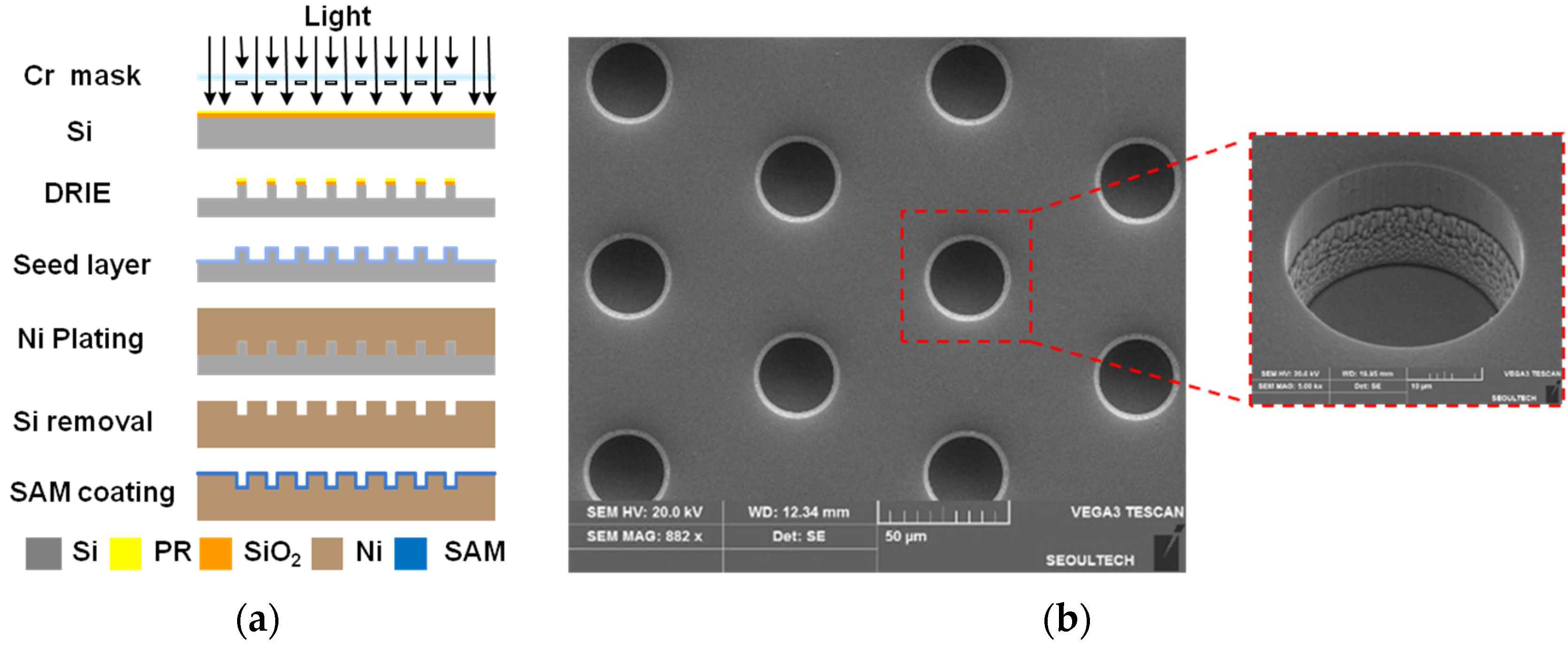
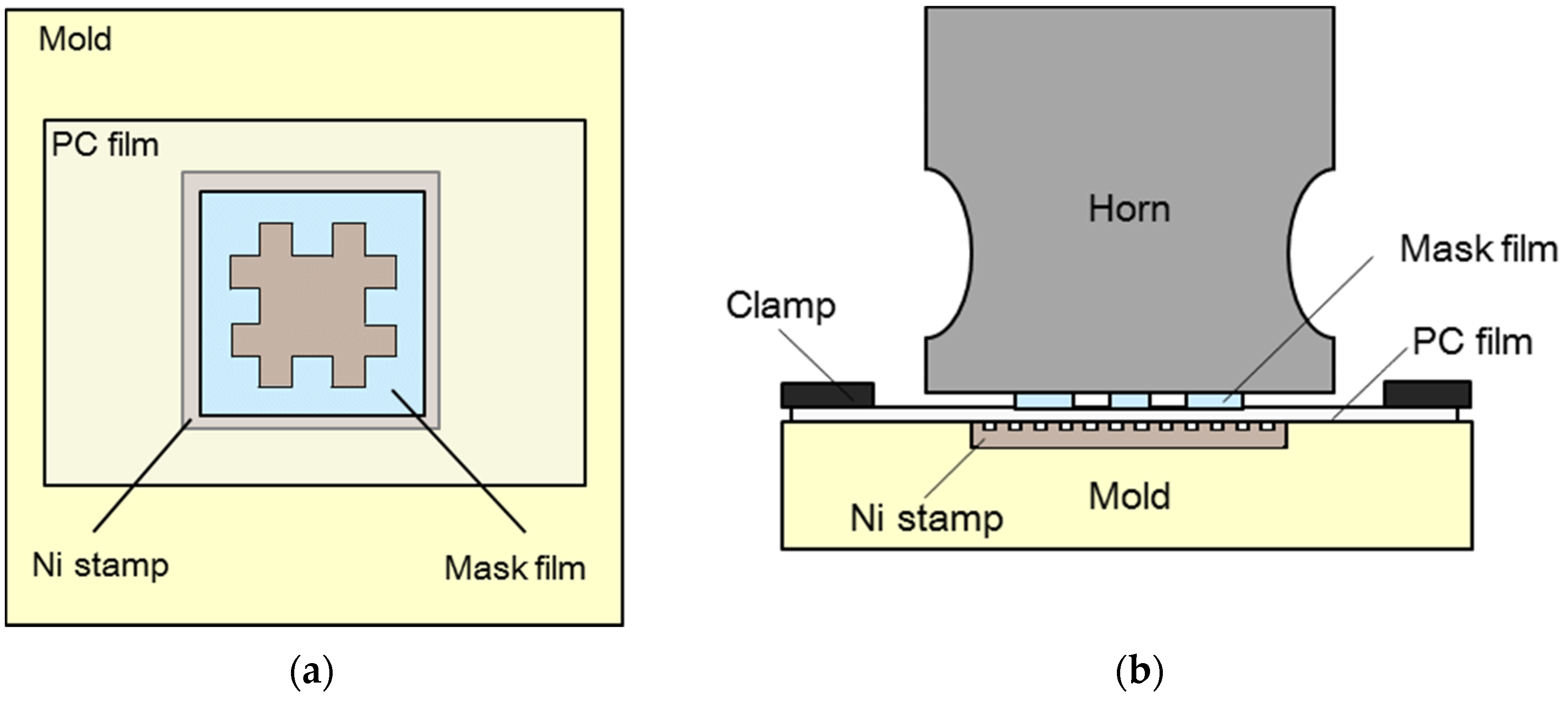
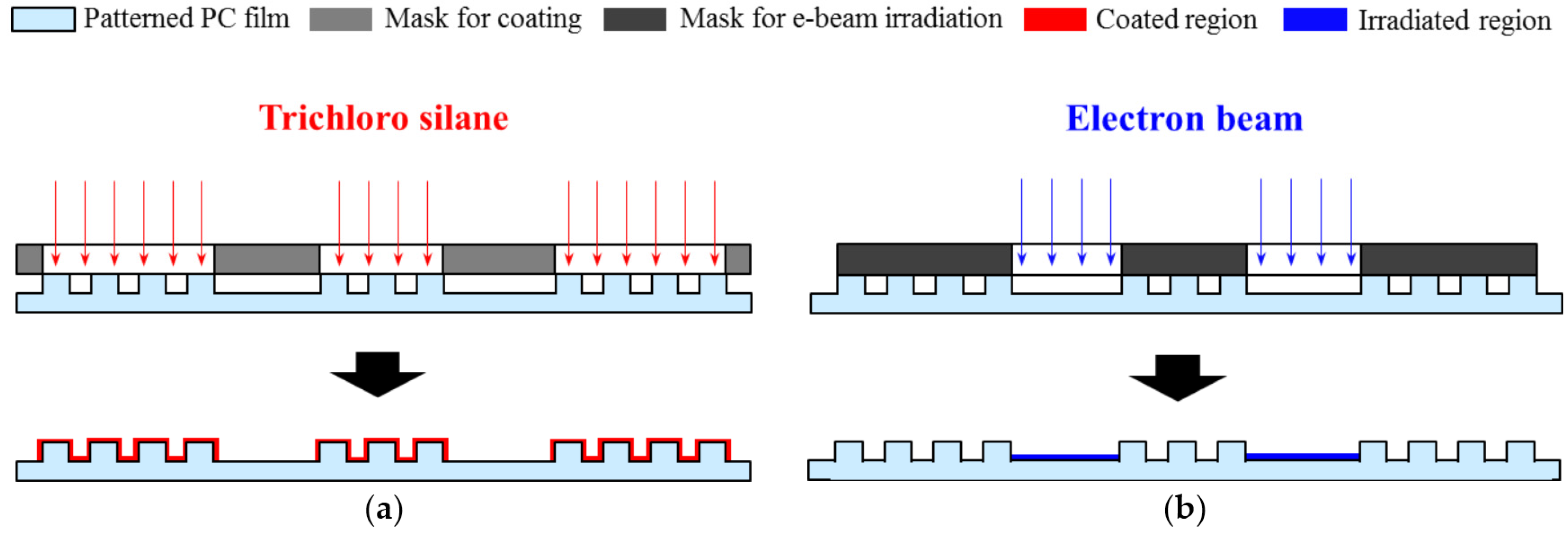
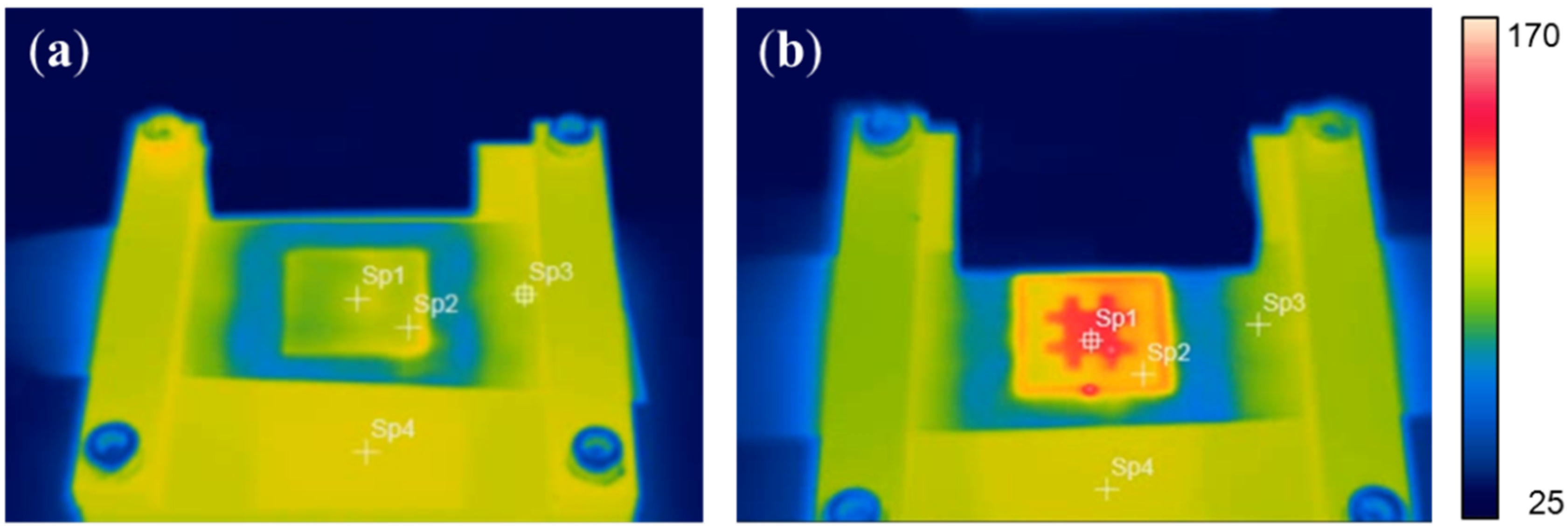
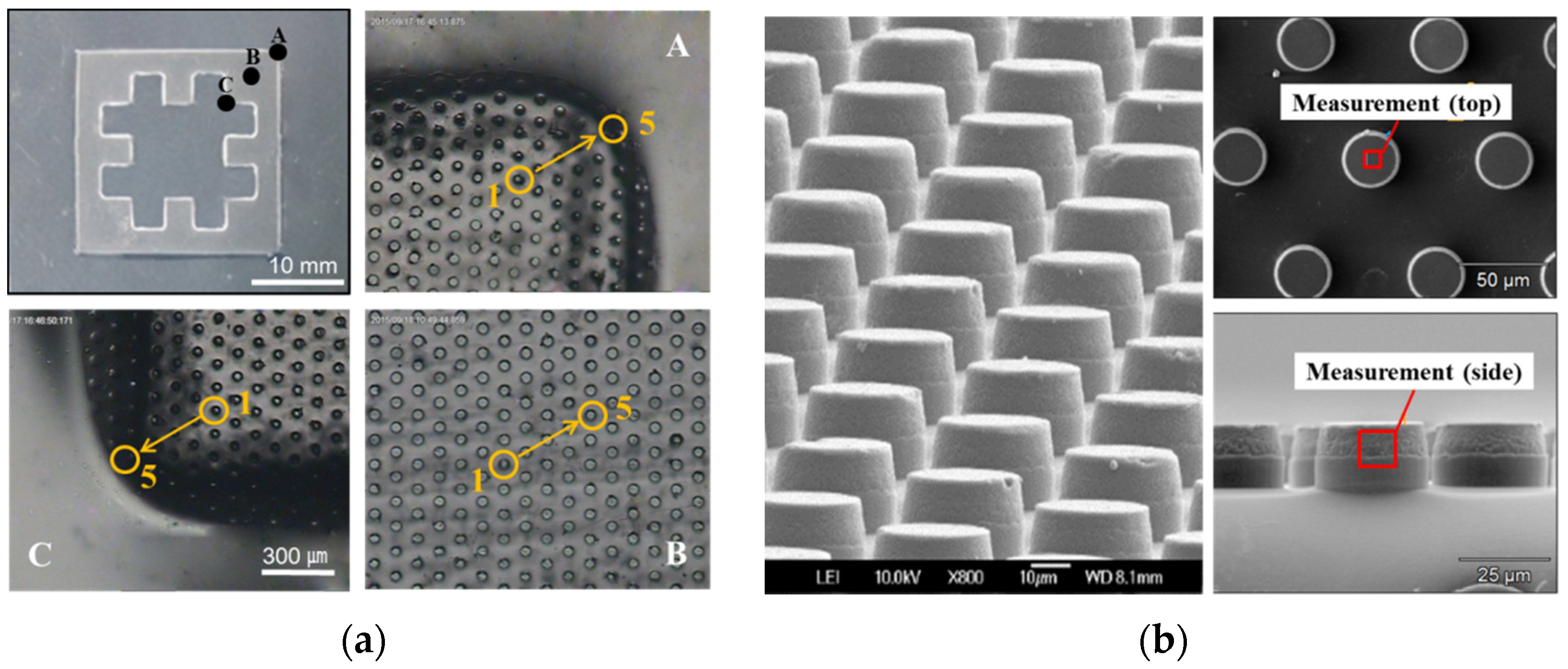



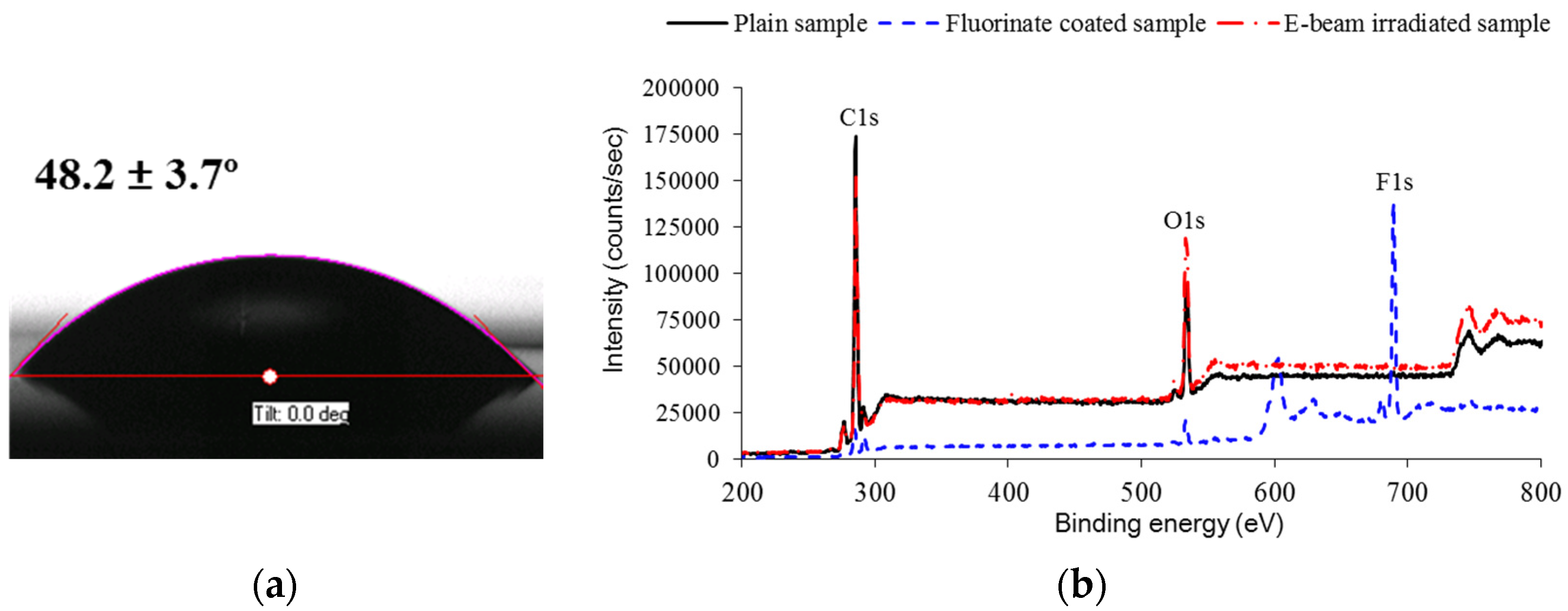

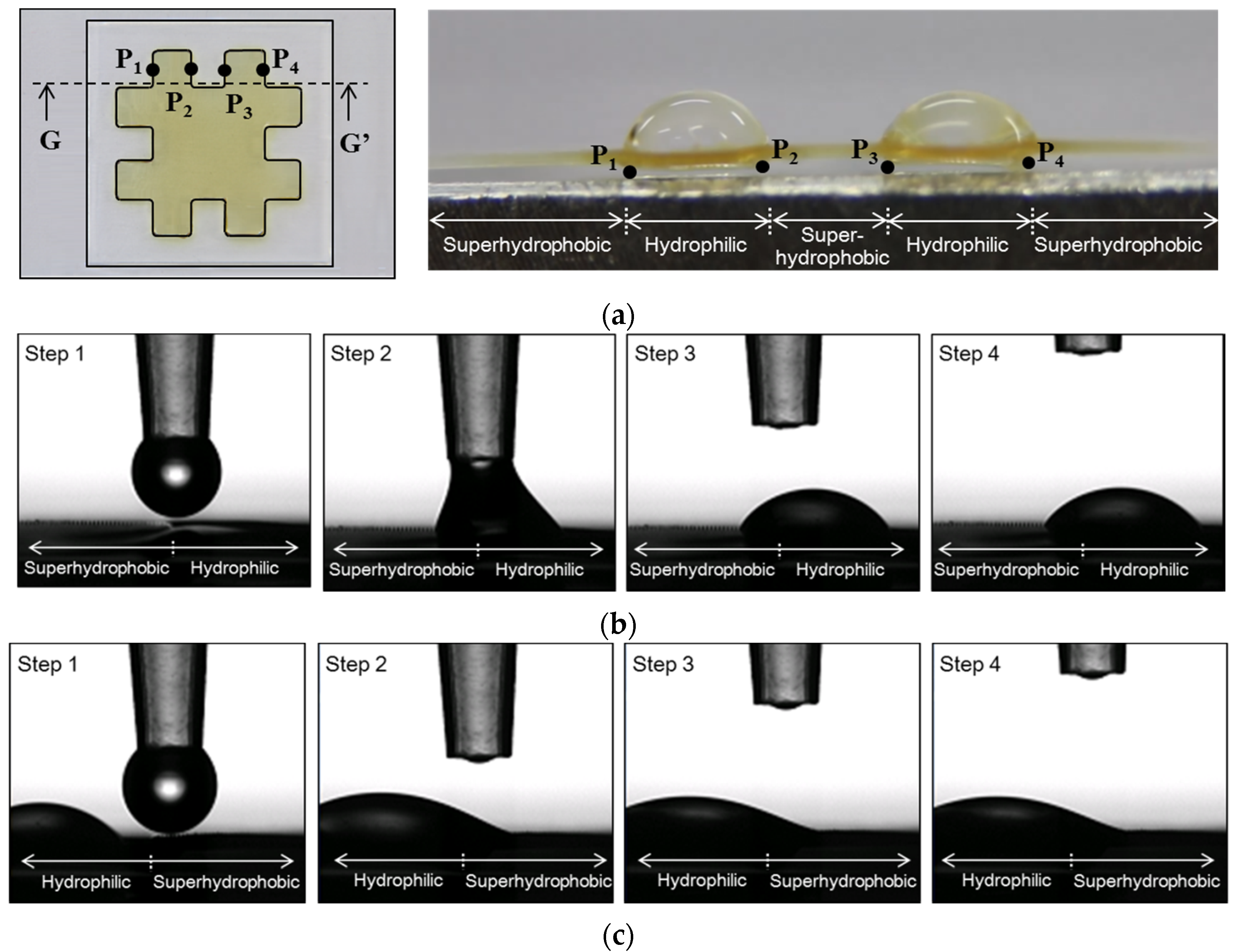

| Elemental Components | Pure (D) | Coated (E) | Irradiated (F) |
|---|---|---|---|
| C1s | 84.1 | 42.9 | 76.0 |
| O1s | 15.9 | 8.3 | 21.8 |
| F1s | – | 44.7 | – |
| N1s | – | – | 2.2 |
| Si2p | – | 4.1 | – |
© 2016 by the authors; licensee MDPI, Basel, Switzerland. This article is an open access article distributed under the terms and conditions of the Creative Commons by Attribution (CC-BY) license (http://creativecommons.org/licenses/by/4.0/).
Share and Cite
Lee, H.-J.; Park, K. Development of Hybrid Surfaces with Tunable Wettability by Selective Surface Modifications. Materials 2016, 9, 136. https://doi.org/10.3390/ma9030136
Lee H-J, Park K. Development of Hybrid Surfaces with Tunable Wettability by Selective Surface Modifications. Materials. 2016; 9(3):136. https://doi.org/10.3390/ma9030136
Chicago/Turabian StyleLee, Hyun-Joong, and Keun Park. 2016. "Development of Hybrid Surfaces with Tunable Wettability by Selective Surface Modifications" Materials 9, no. 3: 136. https://doi.org/10.3390/ma9030136






